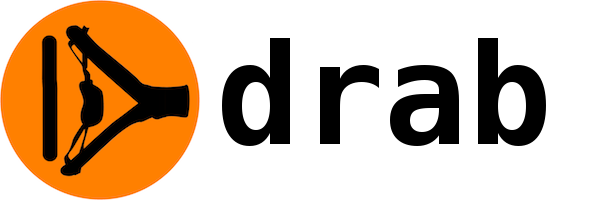See Demo Page for live demo and description.
Drab - Access the browser User Interface from the Server Side. No Javascript programming needed anymore!
Drab extends Phoenix Framework to "remote control" UI on the browser, live. The idea is to move all User Interface logic to the server-side, to eliminate Javascript and Ajax calls.
- Client side:
<div class="progress">
<div class="progress-bar <%= @progress_bar_class %>" role="progressbar" @style.width=<%= "#{@bar_width}%" %>>
<%= "#{@bar_width}%" %>
</div>
</div>
<button class="btn btn-primary" drab-click="perform_long_process">
<%= @long_process_button_text %>
</button>- Server side:
def perform_long_process(socket, _sender) do
poke socket, progress_bar_class: "progress-bar-danger", long_process_button_text: "Processing..."
steps = :rand.uniform(100)
for i <- 1..steps do
Process.sleep(:rand.uniform(500)) #simulate real work
poke socket, bar_width: Float.round(i * 100 / steps, 2)
end
poke socket, progress_bar_class: "progress-bar-success", long_process_button_text: "Click me to restart"
end-
Erlang ~> 19
-
Elixir ~> 1.4
-
Phoenix ~> 1.2
-
Brunch
So far the process of the installation is rather manual. In the future it will be automated.
- Add
drabto your list of dependencies inmix.exsin your Phoenix application and install it:
def deps do
[{:drab, "~> 0.5"}]
end$ mix deps.get
$ mix compile- Initialize Drab client library by adding to the layout page (
web/templates/layout/app.html.eex)
<%= Drab.Client.js(@conn) %>just after the following line:
<script src="<%= static_path(@conn, "/js/app.js") %>"></script>- Initialize Drab sockets by adding the following to
web/channels/user_socket.ex:
use Drab.Socket- Add Drab template engine to
config.exs:
config :phoenix, :template_engines,
drab: Drab.Live.Engine- Add
:drabto applications started by default inmix.exs:
def application do
[mod: {MyApp, []},
applications: [:phoenix, :phoenix_pubsub, :phoenix_html, :cowboy, :logger, :gettext, :drab]]
end- To enable live reload on Drab pages, add
.drabextension to live reload patterns indev.exs:
config :my_app, MyApp.Endpoint,
live_reload: [
patterns: [
~r{priv/static/.*(js|css|png|jpeg|jpg|gif|svg)$},
~r{priv/gettext/.*(po)$},
~r{web/views/.*(ex)$},
~r{web/templates/.*(eex|drab)$}
]
]- Add
jqueryandboostraptopackage.json:
"dependencies": {
"jquery": ">= 3.1.1",
"bootstrap": "~3.3.7"
}- Add jQuery as a global at the end of
brunch-config.js:
npm: {globals: {
$: 'jquery',
jQuery: 'jquery',
bootstrap: 'bootstrap'
}}- And install it:
$ npm install && node_modules/brunch/bin/brunch build Congratulations! You have installed Drab and you can proceed with your own commanders.
All the Drab functions (callbacks, event handlers) are placed in the module called Commander.
Think about it as a controller for the live pages. Commanders should be placed in web/commanders directory.
To enable Drab on specific pages, you need to add the directive use Drab.Controller to your controller.
Remember the difference: controller renders the page, while commander works on the live page.
- Generate the page Commander. The commander name should correspond to the controller, so PageController should have PageCommander:
$ mix drab.gen.commander Page
* creating web/commanders/page_commander.ex
Add the following line to your Example.PageController:
use Drab.Controller - As described in the previous task, add
Drab.Controllerto your page Controller (eg.web/controllers/page_controller.exin the default app):
defmodule MyApp.PageController do
use Example.Web, :controller
use Drab.Controller
def index(conn, _params) do
render conn, "index.html", welcome_text: "Welcome to Phoenix!"
end
end Also add the @welcome_text assign to render/3 in index action, to be used in the future.
-
Rename the template from
web/templates/page/index.html.eextoindex.html.drab -
Edit the template
web/templates/page/index.html.draband change the fixed welcome text to the assign:
<div class="jumbotron">
<h2><%= @welcome_text %></h2>- Edit the commander file
web/commanders/page_commander.exand add some real action - theonloadcallback, which fires when the browser connects to the Drab server:
defmodule DrabExample.PageCommander do
use Drab.Commander
onload :page_loaded
# Drab Callbacks
def page_loaded(socket) do
poke socket, welcome_text: "This page has been drabbed"
set_prop socket, "div.jumbotron p.lead",
innerHTML: "Please visit <a href='https://tg.pl/drab'>Drab</a> page for more"
end
endThe poke/2 function updates the assign. The set_prop/3 updates any property of the DOM object. All is done live, without reloading the page.
- Run
iex -S mix phoenix.server. Go tohttp://localhost:4000to see the changed web page. Now you may play with this page live, directly fromiex! Observe the instruction given when your browser connects to the page:
[debug]
Started Drab for same_path:/, handling events in DrabExample.PageCommander
You may debug Drab functions in IEx by copy/paste the following:
import Drab.{Core, Element, Live}
socket = Drab.get_socket(pid("0.653.0"))
Examples:
socket |> exec_js("alert('hello from IEx!')")
socket |> poke(count: 42)As instructed, copy and paste those to lines, and check out yourself how could you remote control the displayed page:
iex> poke socket, welcome_text: "WOW, this is nice"
%Phoenix.Socket{...}
iex> query socket, "div.jumbotron h2", :innerText
{:ok,
%{"[drab-id='425d4f73-9c14-4189-992b-41539377c9eb']" => %{"innerText" => "WOW, this is nice"}}}
iex> set_style socket, "div.jumbotron", backgroundColor: "red"
{:ok, 1}The example above is available here
Visit Demo Page for a live demo and more description.
Visit Documentation page.
There is a Drab's thread on elixirforum.com, please address questions there.
Since 0.3.2, Drab is equipped with its own Phoenix Server for automatic integration tests and for sandboxing and play with it.
- clone Drab from github:
git clone [email protected]:grych/drab.git
cd drab- get deps and node modules:
mix deps.get
npm install && node_modules/brunch/bin/brunch build- start Phoenix with Drab:
iex -S mix phoenix.server-
open the browser and navigate to http://localhost:4000
-
follow the instructions in IEx to play with Drab functions:
import Drab.{Core, Live, Element, Query, Waiter}
socket = Drab.get_socket(pid("0.784.0"))
iex> query socket, "h3", :innerText
{:ok,
%{"#header" => %{"innerText" => "Drab Tests"},
"#page_loaded_indicator" => %{"innerText" => "Page Loaded"}}}
iex> set_prop socket, "h3", innerText: "Updated from IEx"
{:ok, 2}
iex> exec_js socket, "alert('You do like alerts!')"
{:ok, nil}Most of the Drab tests are integration (end-to-end) tests, thus they require automated browser. Drab uses chromedriver, which must be running while you run tests.
- clone Drab from github:
git clone [email protected]:grych/drab.git
cd drab- get deps and node modules:
mix deps.get
npm install && node_modules/brunch/bin/brunch build-
run
chromedriver -
run tests:
% mix test
Compiling 23 files (.ex)
........................................
Finished in 120.9 seconds
123 tests, 0 failures
Randomized with seed 934572(c)2016-2017 Tomek "Grych" Gryszkiewicz, [email protected]
Illustrations by https://www.vecteezy.com




